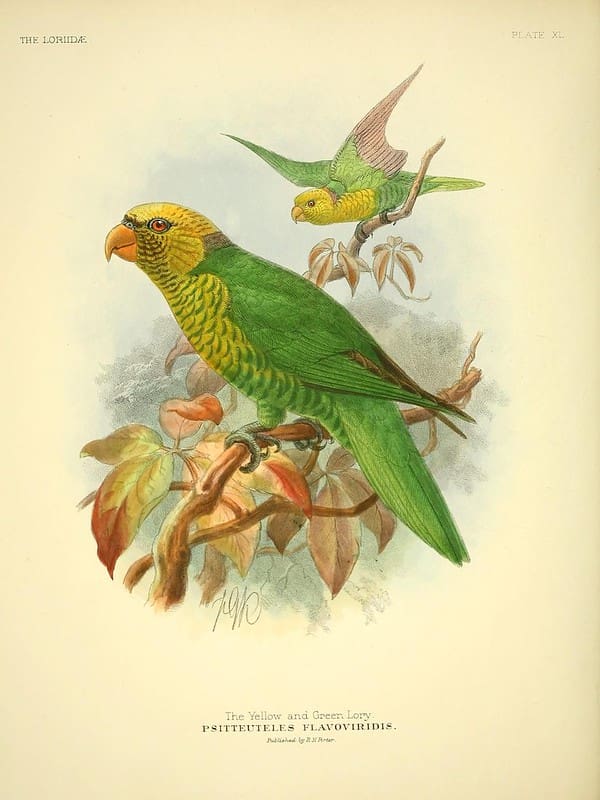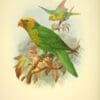Yellow and Green Lorikeet
Also known as:
Yellow-green Lorikeet, Sula Lorikeet, Citrine Lorikeet
Also known as:
Yellow-green Lorikeet, Sula Lorikeet, Citrine Lorikeet

Trichoglossus

flavoviridis
Size:
20 cm (7.8 in)
Weight:
80-95 g (2.8-3.3 oz)
Subspecies including nominate:
one
Colour Adult:
Both adults in general green; olive/yellow forehead and crown; nuchal collar brown; yellow throat and breast to abdomen, with dark green scalloping; yellow/green flanks to undertail coverts; yellow/green underwing coverts. Beak orange/yellow. Lores and eye-ring bare and pink/orange. Eye orange/yellow.
Colour Juvenile:
More green where yellow markings are. Beak brown. Lores and eye-ring bare and white. Eye brown.
Call:
Calls made in flight are high-pitched and screechy. While feeding in flocks birds give series of moderately pitched, slurred squeaky chattering notes with upward inflection. Also emits high-pitched whistles.
More Information:
Content Sources:
CITES
The Lory Link
BirdLife International
Cornell Lab of Ornithology/Birds of the World
Parrots: A Guide to Parrots of the World, Juniper and Parr, 1998
Parrots of the World, Forshaw, 2006. 2010 edition
Parrots in Aviculture, Low, 1992.
Lexicon of Parrots, Thomas Arndt.
Parrots: Their Care and Breeding, Low, 1986.
Captive Status:
Fairly common.
Longevity:
Probably 25-35 yrs.
Housing:
Enclosure with well drained, concrete or tiled floor, or indoor aviary, minimum length 1.8 m (6 ft) within a tiled room for ease of cleaning.
Diet:
Nectar such as a commercial type or homemade from: lactose-free baby cereal, honey and malt extract or molasses, mixed with filtered water and made fresh once or twice daily, and comprising at least 40 percent of the diet; fruits such as: apple, pear, orange, bananas, cactus fruits, pomegranate; vegetables such as: carrot, celery, corn on the cob or frozen sweet corn; green leaves such as: Swiss chard, lettuce, dandelion, sowthistle, chickweed; dried figs soaked in water for a few hours; spray millet; small amount of soaked or sprouted sunflower seed and small amount of canary seed and/or oats.
Enrichment:
Provide bird-safe, unsprayed flowering branches, different sized perches, foraging/puzzle toys, easy-to-clean ladders, noise makers and swings. Also provide overhead misters or shallow water bowls for bathing.
Nest Box Size:
Hinged lid nestbox or L-shaped nestbox, at least 10″ x 10″ x 25″ (25.4 cm x 25.4 cm x 63.5 cm).
Clutch Size:
2
Fledging Age:
7-8 weeks
Hatch Weight:
—
Peak Weight:
—
Weaning Weight:
—
World Population:
Unknown, described as mainly common. Stable.
IUCN Red List Status:
Least Concern
CITES Listing:
Appendix II
Threat Summary:
Not globally threatened. A BirdLife “restricted-range” species. Locally common. On Taliabu, species is most common in montane forest, which is still relatively secure and may be made into a preserve.
Range:
Taliabu, Mangole, and Sulabesi, in Sula Islands.
Habitat:
Found up 800-2000 m (2624-6560 ft) from lowland to upper montane rainforest; also has been seen in open country where Erythrina sp. is flowering, along forest edge and in isolated stands of trees.
Wild Diet:
Feeds on nectar, flowers, fruits, pollen and seeds.
Ecology and Behaviour:
Seen usually in small groups, noisily mixing with Ornate Lorkeets while foraging. Is shy, keeping to dense foliage where it is nearly impossible to detect.
Clutch and Egg Size:
2 eggs
Breeding Season:
Not recorded.
Related Links:
—

